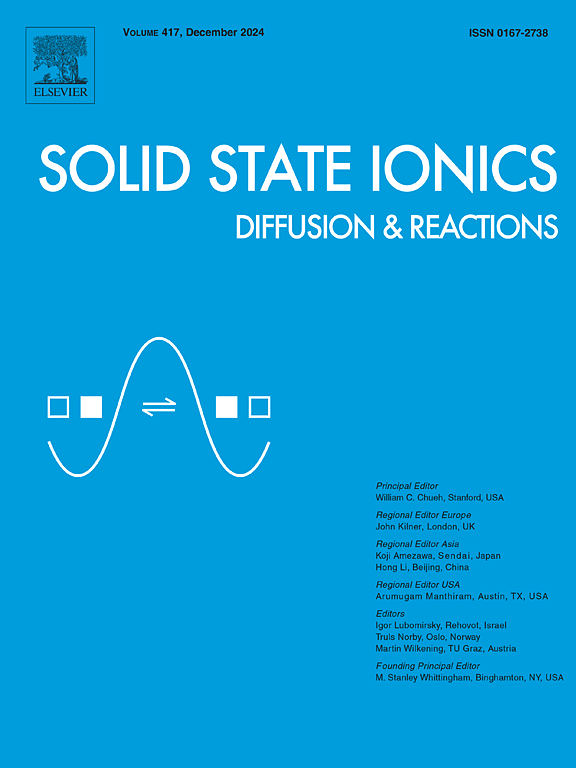Li1.5Al0.5Ge1.5(PO4)3基固体电解质与LiNi1/3Co1/3Mn1/3O2阴极的相容性
IF 3.3
4区 材料科学
Q3 CHEMISTRY, PHYSICAL
引用次数: 0
摘要
与传统锂离子电池相比,全固态电池(assb)具有更高的能量密度和更高的安全性。固体电解质与电极材料之间的高界面电阻问题是assb生产中需要解决的问题。具有nasiconon型结构的Li1.5Al0.5Ge1.5(PO4)3 (LAGP)族固体电解质具有较高的锂离子电导率和空气稳定性。在这项工作中,硅改性LAGP玻璃陶瓷(LAGSP)在25°C时具有3·10−4 S cm−1的总Li+电导率,并且具有致密的微观结构。LiNi1/3Co1/3Mn1/3O2 (NCM)具有较高的比容量和较好的循环性能,是一种很有前途的正极材料。研究了上述组分在高温下形成固-固界面的化学相互作用。采用DSC法研究了固体电解质和正极材料的机械混合物在高达900℃温度下的热行为。采用XRD研究了在500、730、800℃不同温度下热处理后的机械混合物的相组成。结果表明,在500℃热处理后,初始相的组织没有发生变化。而在730℃退火后,Li3PO4、Li4P2O7、NiAl2O4和GeO2相开始出现,而在800℃退火后,形成Co2MnO4、LiCoPO4、SiO2、GeO2、Li3PO4和Li9Al3(P2O7)3(PO4)2相。在800°C下加热会导致固体电解质完全降解。因此,提出了使用液态电解质创建LAGSP | NCM接口。采用lipf6基液体电解质作为固体电解质与阴极之间的缓冲层,增强了界面接触。组装对称的NCM |固体电解质| NCM和NCM |LiPF6 |固体电解质|LiPF6 | NCM电池,并测量其室温电阻。结果表明,与未修饰细胞(162 kΩ·cm2)相比,修饰细胞在室温下的电阻最低(1.2 kΩ·cm2)。本文章由计算机程序翻译,如有差异,请以英文原文为准。
Compatibility between Li1.5Al0.5Ge1.5(PO4)3-based solid electrolyte and LiNi1/3Co1/3Mn1/3O2 cathode
All-solid-state batteries (ASSBs) have a higher energy density and improved safety compared to traditional lithium-ion batteries. The problem of high interface resistance between the solid electrolyte and electrode materials needs to be addressed for the ASSBs production. Solid electrolytes of the Li1.5Al0.5Ge1.5(PO4)3 (LAGP) family with the NASICON-type structure possess a high lithium-ion conductivity and stability in air. In this work, Si-modified LAGP glass-ceramics (LAGSP) with a total Li+ conductivity of 3·10−4 S cm−1 at 25 °C and a compact microstructure is considered. LiNi1/3Co1/3Mn1/3O2 (NCM) is a promising cathode material which offers a high specific capacity and better cycle performance. Chemical interaction between the above-mentioned components at high temperature for the solid-solid interface creation was studied. The thermal behavior of the mechanical mixture of solid electrolyte and cathode material was studied by DSC method at temperatures of up to 900 °C. The phase composition of their mechanical mixture after heat treatment at different temperatures (500, 730 and 800 °C) was investigated by XRD. It was shown that the structure of the initial phases did not change after heat treatment at 500 °C. However, Li3PO4, Li4P2O7, NiAl2O4 and GeO2 phases begin to appear after annealing at 730 °C, while Co2MnO4, LiCoPO4, SiO2, GeO2, Li3PO4 and Li9Al3(P2O7)3(PO4)2 formation was observed at 800 °C. Heating at 800 °C leads to a complete degradation of the solid electrolyte. Therefore, it was proposed to create a LAGSP | NCM interface using a liquid electrolyte. LiPF6-based liquid electrolyte was used as a buffer layer between solid electrolyte and cathode for enhancing the interfacial contact. Symmetrical NCM | solid electrolyte | NCM and NCM |LiPF6 | solid electrolyte | LiPF6 | NCM cells are assembled and their resistance at room temperature is measured. It was established that modified cells had the lowest resistance at room temperature (1.2 kΩ·cm2) compared to unmodified cells (162 kΩ·cm2).
求助全文
通过发布文献求助,成功后即可免费获取论文全文。
去求助
来源期刊

Solid State Ionics
物理-物理:凝聚态物理
CiteScore
6.10
自引率
3.10%
发文量
152
审稿时长
58 days
期刊介绍:
This interdisciplinary journal is devoted to the physics, chemistry and materials science of diffusion, mass transport, and reactivity of solids. The major part of each issue is devoted to articles on:
(i) physics and chemistry of defects in solids;
(ii) reactions in and on solids, e.g. intercalation, corrosion, oxidation, sintering;
(iii) ion transport measurements, mechanisms and theory;
(iv) solid state electrochemistry;
(v) ionically-electronically mixed conducting solids.
Related technological applications are also included, provided their characteristics are interpreted in terms of the basic solid state properties.
Review papers and relevant symposium proceedings are welcome.
 求助内容:
求助内容: 应助结果提醒方式:
应助结果提醒方式:


